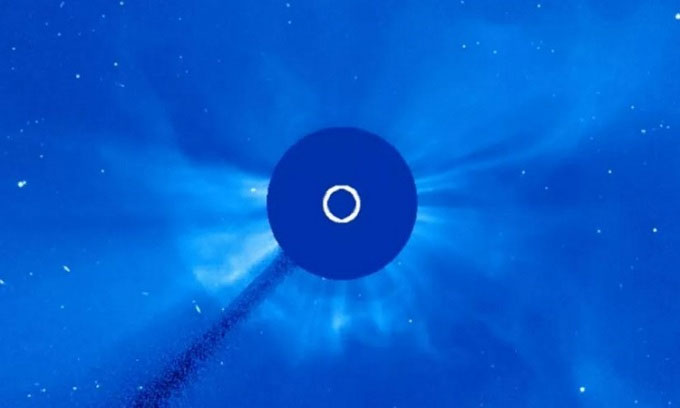A strong solar storm currently has the potential to damage power grids, satellites, and radio signals, but it also creates stunning auroras across North America on November 4.
The Space Weather Prediction Center (SWPC) of the National Oceanic and Atmospheric Administration (NOAA) is monitoring a series of explosive activities from the sun that began on November 1. Since then, the sun has experienced several coronal mass ejections (CMEs). CMEs consist of clouds of plasma and magnetic fields ejected from the sun’s surface. This activity can originate from any area on the sun. The current CMEs are directed straight toward Earth, coinciding with a storm hitting Earth just in time for Halloween.

Coronal mass ejection from the sun on November 2. (Photo: NASA)
SWPC warns that the new geomagnetic storm could impact daily life, including fluctuations in power grid voltage, triggering false alarms in some protective devices, and disrupting satellite positioning.
NOAA operates a series of satellites capable of detecting CMEs. The potential impacts from the current CMEs were detected by the Deep Space Climate Observatory (DSCOVR) spacecraft at the end of November 3, followed by the GOES-16 satellite about 15 minutes later. DSCOVR is located 1.5 million kilometers from Earth in the direction of the sun. GOES-16 is in a geostationary orbit 35,800 kilometers above the equator, specifically monitoring the East Coast of the United States.
In addition to the potential visible impacts on daily life, NOAA states that these phenomena can also affect spacecraft, causing surface charging and orientation issues. The storm may disrupt high-frequency radio signals at high latitudes, affecting long-distance flights. However, geomagnetic storms also create beautiful auroras, which were visible from the night of November 3 to November 4 in states like Pennsylvania, Iowa, Oregon, and many others in the northern region.
Auroras may continue to appear with solar storms ranging from minor (G1) to moderate (G3), according to SWPC’s geomagnetic storm forecast. CMEs and other solar activities can influence conditions within the solar system, collectively referred to as space weather. Space weather is linked to the sun’s 11-year cycle. Currently, the sun is at the beginning of this cycle, expected to peak in 2025.


















































